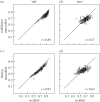Assessing recognition memory using confidence ratings and response times
- PMID: 27152209
- PMCID: PMC4852632
- DOI: 10.1098/rsos.150670
Assessing recognition memory using confidence ratings and response times
Abstract
Classification of stimuli into categories (such as 'old' and 'new' in tests of recognition memory or 'present' versus 'absent' in signal detection tasks) requires the mapping of internal signals to discrete responses. Introspective judgements about a given choice response are regularly employed in research, legal and clinical settings in an effort to measure the signal that is thought to be the basis of the classification decision. Correlations between introspective judgements and task performance suggest that such ratings often do convey information about internal states that are relevant for a given task, but well-known limitations of introspection call the fidelity of this information into question. We investigated to what extent response times can reveal information usually assessed with explicit confidence ratings. We quantitatively compared response times to confidence ratings in their ability to qualify recognition memory decisions and found convergent results suggesting that much of the information from confidence ratings can be obtained from response times.
Keywords: confidence ratings; receiver operating characteristic; recognition memory; response times.
Figures








References
-
- Green DM, Swets JA. 1966. Signal detection theory and psychophysics. New York, NY: John Wiley and Sons Inc.
-
- Busey TA, Tunnicliff J, Loftus GR, Loftus EF. 2000. Accounts of the confidence-accuracy relation in recognition memory. Psychon. Bull. Rev. 7, 26–48. (doi:10.3758/BF03210724) - DOI - PubMed
-
- Jensen MP, Karoly P. 2011. Self-report scales and procedures for assessing pain in adults. In Handbook of pain assessment, 3rd edn (eds DC Turk, R Melzack), pp. 19–44, New York, NY: Guilford Press.
-
- Wundt W. 1862. Beiträge zur Theorie der Sinneswahrnehmung. Leipzig, Germany: C. F. Winter’sche Verlagshandlung.
-
- Baumgartner H, Steenkamp J-BEM. 2001. Response styles in marketing research: a cross-national investigation. J. Marketing Res. 38, 143–156. (doi:10.1509/jmkr.38.2.143.18840) - DOI
LinkOut - more resources
Full Text Sources
Other Literature Sources
Miscellaneous

